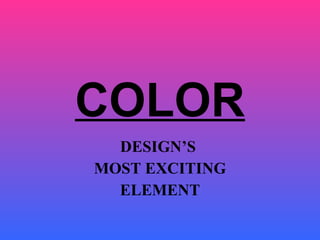
Ed 2201 Redo PowerPoint
- 1. COLOR DESIGN’S MOST EXCITING ELEMENT
- 3. HUE RED YELLOW VIOLET The name given to a color.
- 4. VALUE The lightness or darkness of a color
- 5. TINT Made by adding white to a color so that it is lighter. + = HUE WHITE TINT
- 6. SHADE Made by adding black to a color so that it is darker. + = HUE BLACK SHADE
- 7. INTENSITY The brightness or dullness of a color. FUSCHIA - HIGH INTENSITY OLIVE - LOW INTENSITY
- 8. NEUTRALS (NOT REALLY COLORS) No color All colors White + Black Can be used with most colors White Black Gray Beige
- 9. COLOR WHEEL A GUIDE TO STUDY HOW TO CHOOSE AND COMBINE COLORS
- 12. INTERMEDIATE (TERTIARY) HUES Made by mixing equal amounts of adjoining primary and secondary colors.
- 13. THE COLOR WHEEL CAN BE DIVIDED INTO WARM AND COOL COLORS
- 16. MONOCHROMATIC COLOR SCHEME This is a one-color plan that uses different tints, shades and intensities of the color BLUE
- 17. ANALOGOUS COLOR SCHEME This color scheme uses related, or neighboring colors on the color wheel with varying values and intensities of the colors.
- 18. COMPLEMENTARY COLOR SCHEME This color scheme uses opposite hues on the color wheel. These colors are across from each other on the wheel and have great contrast.
- 19. SPLIT-COMPLEMENTARY COLOR SCHEME This color scheme uses three colors, one color with the two colors on each side of its complement. VIOLET
- 20. TRIAD COLOR SCHEME This color scheme combines three colors equidistant on the color wheel and has a great deal of contrast.
- 21. ACCENTED NEUTRAL COLOR SCHEME This color scheme combines white, black, gray or sometimes beige with a bright color accent.
- 22. All colors are beautiful, depending on personal taste. If not used wisely or combined well, color can cause apparel to look too gaudy or very drab. Harmony results when hues, values and intensities are combined in a pleasing way.